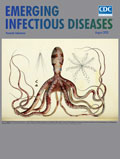
Volume 26, Number 8—August 2020
Research
Analysis of MarketScan Data for Immunosuppressive Conditions and Hospitalizations for Acute Respiratory Illness, United States
Manish Patel , Jufu Chen, Sara Kim, Shikha Garg, Brendan Flannery, Zaid Haddadin, Danielle Rankin, Natasha Halasa, H. Keipp Talbot, and Carrie Reed
, Jufu Chen, Sara Kim, Shikha Garg, Brendan Flannery, Zaid Haddadin, Danielle Rankin, Natasha Halasa, H. Keipp Talbot, and Carrie Reed
Abstract
Increasing use of immunosuppressive biologic therapies poses a challenge for infectious diseases. Immunosuppressed patients have a high risk for influenza complications and an impaired immune response to vaccines. The total burden of immunosuppressive conditions in the United States, including those receiving emerging biologic therapies, remains unknown. We used the national claims database MarketScan to estimate the prevalence of immunosuppressive conditions and risk for acute respiratory illnesses (ARIs). We studied 47.2 million unique enrollees, representing 115 million person-years of observation during 2012–2017, and identified immunosuppressive conditions in 6.2% adults 18–64 years of age and 2.6% of children <18 years of age. Among 542,105 ARI hospitalizations, 32% of patients had immunosuppressive conditions. The risk for ARI hospitalizations was higher among enrollees with immunosuppression than among nonimmunosuppressed enrollees. Future efforts should focus on developing improved strategies, including vaccines, for preventing influenza in immunosuppressed patients, who are an increasing population in the United States.
Influenza is a common cause of illness and death in the United States and affects persons of all ages (1). Risk for complications from infection is higher in subpopulations, such as persons with immunosuppressive conditions (2,3). In recent years, an increasing number of patients are receiving biologic or immune-modulating agents with immunosuppressive potential (4,5). Although data exist on the prevalence of some immunosuppressive conditions, the total burden of these conditions in the United States remains unknown, particularly when considering patients who are receiving emerging immunosuppressive therapies (6–8).
Influenza vaccination prevents disease and averts severe outcomes, such as hospitalization and death (1,9). A meta-analysis of observational studies of influenza vaccines identified that pooled vaccine effectiveness was 33%–67% against medically attended, laboratory-confirmed influenza illness in the overall population (10). However, a review of immunogenicity studies suggests that antibody responses to inactivated influenza vaccines (IIVs) in persons who are immunocompromised could be suboptimal compared with persons without immunosuppression (11).
Clinical effectiveness data are sparse, but a recent observational study demonstrated lower vaccine effectiveness against influenza illness (≈20%) in patients with cancer compared with the general population (≈42%) (12,13). Increasing efficacy of influenza vaccines in immunosuppressed populations might substantially improve population benefits of influenza vaccines. Establishing a case definition for and quantifying the burden of immunosuppressive conditions might facilitate evaluation and use of influenza vaccines to enhance immune response in this high-risk target group.
IIVs that contain egg-propagated vaccine viruses and a standard dose of 15 μg of hemagglutinin antigen of each virus per dose, without adjuvant, are the most commonly used vaccines worldwide (14). In recent years, 2 enhanced IIVs, MF59-adjuvanted standard-dose IIV and a high-dose IIV that contains 4 times the hemagglutinin antigen of each virus compared with the standard-dose IIV, have been developed to improve the immune responses to and efficacy of standard-dose IIVs (15,16). Both vaccines are currently licensed in the United States for use in older adults (9). High-dose IIV has also met prespecified criteria for superior efficacy against laboratory-confirmed influenza compared with standard-dose IIV (15,17). Although these enhanced IIVs are not yet licensed for use in US patients <65 years of age, some evidence suggests that humoral immune responses to these vaccines might also be greater than responses to standard IIVs in adults 18–64 years of age who have immunosuppressive conditions (18,19).
In this study, we created and used case definitions for immunosuppressive conditions by using a modified version of an algorithm implemented by previous investigators (20). Our primary objective was to determine the prevalence of immunosuppressive conditions in the US population among MarketScan (Truven Health MarketScan, ) enrollees <65 years of age. We recognized that International Classification of Diseases (ICD) and drug codes might not accurately capture enrollees with impaired immune systems. Thus, our secondary objective was to explore whether rates of influenza vaccination and hospitalization for acute respiratory infection (ARI) differed between those with and without immunosuppressive conditions identified by our case definitions.






















.png)











No hay comentarios:
Publicar un comentario